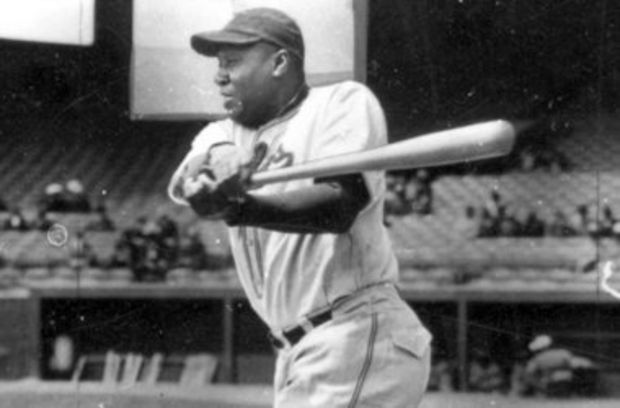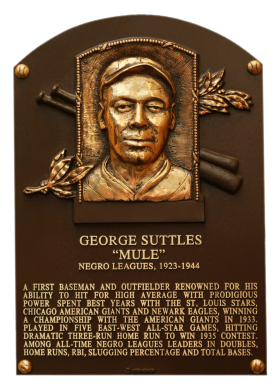Historical Hitter August 11 1935: Mule Suttles

The 1935 East West All Star game played at Comiski Park in Chicago was the scene for historical hitting heroics. With two out and two on in the bottom of the 11, Mule Suttles of the Chicago American Giants hit a three run walk off home run.
Here is the box score:
| Team | 1 | 2 | 3 | 4 | 5 | 6 | 7 | 8 | 9 | 10 | 11 | R | H | E | |
| East | 2 | 0 | 0 | 1 | 1 | 0 | 0 | 0 | 0 | 4 | 0 | 8 | 11 | 5 | |
| West | 0 | 0 | 0 | 0 | 0 | 3 | 1 | 0 | 0 | 4 | 3 | 11 | 11 | 5 | |
| WP: Sug Cornelius (Chicago American Giants) LP: Martín Dihigo (New York Cubans) Home runs: East: Slim Jones (Philadelphia Stars) West: Mule Suttles (Chicago American Giants) Attendance: 25,000 (est.) |
|||||||||||||||
Adding drama and trickery to the moment, Suttles had pitcher Sug Cornelius kneel in the on deck circle to fool the eastern all-star pitcher. The stunt worked and Josh Gibson was intentionally walked. With Cool Papa Bell on second, and Josh Gibson on first, and two out, Mule Suttles stepped up the plate. Although known as a free swinger and prone to striking out, unlike Casey of baseball lore, Mule ending the game in dramatic and heroic fashion with a towering home run into the Chicago night.
Mule Suttles was one of the best home run hitters of the not just the Negro Leagues but of all baseball. He was described as a hulk of a man who with this 50 oz. bat hit the ball further, harder, and higher than anyone. Here are two stories that describe his power and presence at the plate.
[Suttles] hit a home run one night in Buffalo [that] hit the house across the street and came back in the ball park. We got the ball and held him to two bases. The ball went out of the park and hit the house so quickly and came back into the park that the umpire thought it hit the fence. “Turkey & Mule,” by John Murphy in steamheads.com.
The players would yell “Kick Mule!” and he would “kick” it out of the park. In Havana’s Tropical Park, the centerfield fence is 60 feet high and more than 500 feet from the plate. Teammate Willie Wells recalled a gargantuan drive that carried over the heads of the soldiers on horseback riding crowd control duty behind the fence, a total of about 600 feet. Afterward, a marker was placed at the spot, commemorating the prodigious homer. From http://coe.k-state.edu/annex/nlbemuseum/history/players/suttles.html
Born in Alabama in 1900 and died from cancer in 1966 as a resident of Newark, NJ. He was elected to the Alabama Sports Hall of Fame, Negro Leagues Hall of Fame and the Baseball Hall of Fame posthumously in 2006.
Here is his official bio from the Hall:
But the evolution of baseball into the true National Pastime – when all men had the chance to play the game – didn’t happen for another four decades. And it was the men born a century ago – like future Hall of Famer George “Mule” Suttles – who helped make that possible.
Suttles was born March 31, 1900, in Blocton, Ala., arriving on the baseball scene just as the Negro National League was asserting itself as a thriving business. From 1923 through 1944, Suttles was one of the most feared sluggers in the Negro leagues.
A right-handed hitting first baseman, Suttles starred for a number of teams, including the Birmingham Black Barons, the St. Louis Stars, the Chicago American Giants and the Newark Eagles. The 6-foot-3, 215-pound Suttles played in five East-West All-Star Games, and carved his name into history in the 1935 contest when he hit a game-winning three-run home run off of another future Hall of Famer, Martin Dihigo.
Statistics from those years are incomplete, but Suttles is credited with 894 hits in 763 career league-sanctioned games, good for a .327 batting average.
The high-caliber play of Suttles and others helped establish the ability of African-American players to compete at the highest level – opening the door for the eventual integration of the major leagues by Jackie Robinson in 1947.
Suttles died on July 9, 1966, in Newark, N.J. He was elected to the Hall of Fame in 2006.

